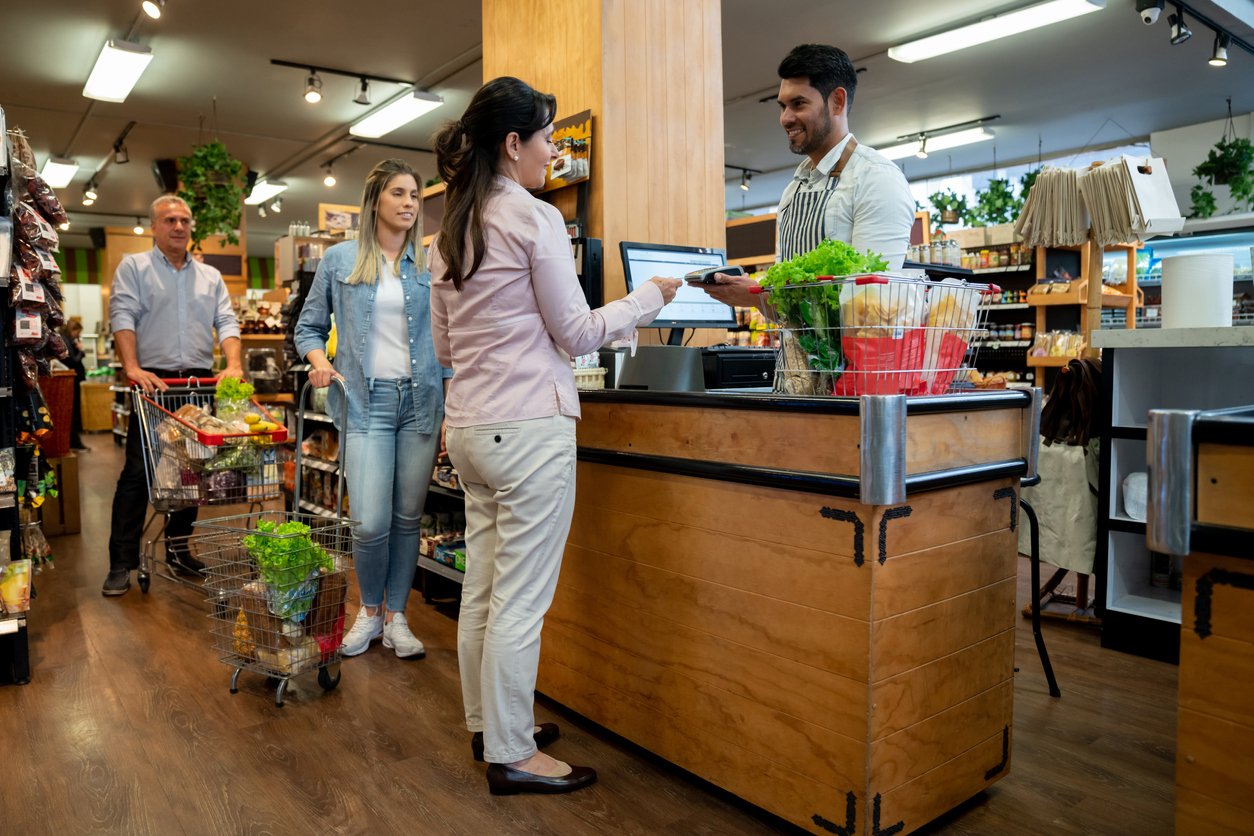4 Opportunities To Improve Customer Satisfaction While Waiting In Line

6 Feb 2023
“Waiting” and “customer satisfaction” are not concepts that go together naturally. For most people, waiting in line is associated with some of the not-so-fun memories in life: spending hours trying to get on an amusement park ride, paying a visit to your local government agency or hanging out in the lobby of a doctor’s office.
In truth, each waiting line represents an opportunity to improve customer satisfaction.
You may be wondering how this is possible. More than anything, waiting lines can seem like a great source of customer dissatisfaction. Messing them up leads to more dissatisfaction, so why even try tampering with the status quo of how people are lining up?
It’s true, people do hate to wait. But since it’s a negative experience for most people, improving a customer’s waiting line experience is a surefire way to make sure your clients maintain a good overall impression of your business. At best, you could even transform the way they perceive their business.
84% of customers value customer experience more than anything else, even service value. Better customer experience translates into better business.
Interested in learning about the history, psychology, and best practices of waiting in line? Read on to find out more.
The History of Waiting Lines
Believe it or not, people have not actually been waiting in line since the beginning of time. Queueing is a relatively recent invention, and it arose from the French Revolution-era when people were waiting in line for limited supplies of bread.
That’s a common theme in the history of queueing: without the concept of high demand and low supply, most wouldn’t be willing to line up in the first place. But more breakthroughs on the way people thought about queueing didn’t arrive until later.
In 1909, a Danish engineer A.K. Erlang invented queueing theory to operate the Danish Telephone Exchange more efficiently. According to him, there are two main parties to consider in lining up: the requesting party (clients, customers, etc.) and the delivering party (business, company, etc.).
Although his theory didn’t mark the beginning of queueing, it was one of the first times people thought about waiting in line with a more critical mindset. Nowadays even solutions as advanced as virtual location queueing services still draw inspiration from the questions he posed.
How many customers/servers are there? What’s the speed at which the business completes requests? How big is the waiting zone? Are people staying in line or do they tend to become disorderly? Is there a way to speed up transportation? What’s the best way to deliver customer service at any given point in line?
All these questions and more were enough to inspire companies to begin thinking about lining up as an integral part of the customer experience. Leaving any part of business up to chance doesn’t make for the most efficient service possible.
The next step was to bring psychology into the mix.
The Psychology of People Waiting in Line

Yes, people hate to wait. But there’s more to the psychology of waiting in line than just that simple fact. Learning more about how people feel about waiting will help you make better business decisions down the road.
Here are a few quick facts about waiting:
- Customers will wait for something they think is more desirable. Compare the patience of people waiting in line for a driver’s license and the people waiting for luxury brand clothing. Higher perceived value = more willingness to wait.
- People copy each other’s behavior. Rowdy lines? People aren’t going to stay orderly. If everyone else is keeping the peace, most people won’t want to be the first to disrupt that.
- Unoccupied waits feel longer than occupied waits. Time passes faster when your clients aren’t just focused on the act of waiting itself.
- The worse the mood, the worse the wait. If something has already happened to test your customers’ patience, you don’t want to keep them waiting for much long after.
- Waiting alone sucks. Even if your customers don’t talk to each other, just having others around them who are also waiting will make them feel better.
- More orderly lines are more satisfying to wait in. Nobody will be content to wait around if there’s no rationale behind queues at your business. Showing people that they are waiting in a fair line will inspire them to wait longer.
Not all of your customers are going to play by the rules, especially if they get restless. You might experience people trying to cut ahead in line, friends saving spots for other friends, those who don’t have a sense of personal space.
Don’t be shy about setting rules. People behave better when there are clear expectations placed on them about how to act. Retailers are a great example of this since there are often queues out of the door for certain desirable objects. Setting up a lane with even just a roped-off waiting zone helps people stay in line and automatically designates a place for them to wait in order.
There’s no single mindset when it comes to waiting in line. But the better you understand the range of emotions your customers may be feeling when they wait in line, the better you will be able to service them.
4 Opportunities to Improve Customer Satisfaction in A Waiting Line

Messing up the waiting line system at your business location can lead to great chaos. All the same, where there is a crisis, there can also be an opportunity.
Streamlining your waiting line system has the potential to improve overall satisfaction at your business. Here are four tangible ways you can improve customer satisfaction while people wait in line:
- Entertain to Distract
- Establish Ground Rules
- Manage Expectations
- Shorten Queues When You Can
Opportunity 1: Entertain to Distract
Keeping in mind that unoccupied waits feel longer than occupied waits, you should be aiming to keep your customers distracted. What better way to distract people than to actively entertain them?
Disneyland queues are a great example of this. Even waiting in line, you’ll never go bored for a moment. There are constant sources of entertainment: parades to watch, snacks to eat, live characters to interact with, fireworks to gape at.
Of course, you don’t have to be a beloved theme park to implement creative queueing entertainment. Just setting up screens or signage in the waiting area can give customers something to look at and keep them distracted for the time being. You can be in any industry from retail to telecommunications to hospitality: setting up a screen or two will still divert customers’ attention away from the wait.
Self-entertainment is also very powerful. If you can set up a system where people are encouraged to keep themselves distracted, you won’t have to worry about spending money on their entertainment at all.
Here’s a handy chart if you want to compare the different ways to keep people distracted in terms of how well they work for you and your customers:
| Entertainment Value | Pricing | Branding | |
| Flat Signage | ✕ | ✓ | ✓ |
| Videos/Movies | ✓ | Depends (licensing, production, screens?) | ✓ |
| Promotion (Videos/Signs/Social Media) | ✕ | ✕ | ✓ |
| Interactive Games | ✓ | ✕ | Branded Games: ✓ Non-Branded Games: |
| Self-Entertainment | ✓ | ✓ | ✓ |
As you can see, self-entertainment is the most powerful solution when implemented correctly. You can create pop up alerts, promotional content, and signage at will through their smartphones alone. Virtual queueing lets customers have what they value the most: time and freedom.
Using a queue management system that allows your customers to wait wherever they want and do whatever they want in the meantime doesn’t just let them distract or entertain themselves. It frees them up and eliminates the line altogether.
Opportunity 2: Establish Ground Rules

You should never be shy about making rules. This point bears repeating because it’s very important.
In many ways, offering customers guidance is a similar principle to “entertain to distract”. An empty waiting area is like a blank canvas. While some of your clients will know the appropriate way to act, others might have more “creative” ideas such as cutting in line, pushing, or general disorderly conduct.
Without rules in place, people won’t feel as bad when interrupting an implicit order of your line. All the more reason to establish actual explicit guidance for your clients so they know how to wait in line.
What are some good ways to guide customers along their way in a waiting line? Here are five suggestions:
- Signage. Simple and classic, putting down a sign will help your clients figure out where to go.
- Lanes. Separating customers into lanes can help them feel like they haven’t been waiting for so long.
- Serpentine lines. According to queue theorists, implementing a long winding line called a serpentine line reduces the waiting time by a great deal.
- Staff. Depending on your resources, having actual people on-the-ground to guide customers to where they need to be may lend an additional human touch to your service.
- Push notifications. If you’re using a mobile-compatible solution, pushing notifications to your customer’s smart device will alert them in real-time.
However, you decide to notify people waiting in line, make sure you do so clearly and in a visible manner. Bright, noticeable signage or notifications that find customers where they are will assist them in getting where they need to.
Opportunity 3: Manage Expectations
There’s nothing inherently wrong with making the customer wait. But the worst thing you can do is leave people waiting without giving them an idea of what to expect. Waits fraught with uncertainty will feel longer than waiting lines with clearly established information available to your visitors.
Even if your customers don’t take immediate advantage of the information you’re offering them, making it available to them lets them manage their expectations a lot better.
People want to know:
- How long will they be waiting?
- Where will they go next?
- What is the internal order governing this queue?
- Are there any surprise circumstances that might extend this wait?
- What kind of service exactly is waiting for them at the end of the line?
Answering these questions upfront with signage, virtual or physical, will ease your customer’s minds. Managers should be monitoring your queues, keeping a close eye on how they move and keeping people updated when they are waiting in line.
Another part of managing expectations is playing up the perceived value of your service. Since people are willing to wait longer for what they think are more valuable products, convincing them why they should be waiting that long in line is part of the battle in justifying why your customer is waiting in line in the first place.
Opportunity 4: Shorten Queues When You Can

Although for many businesses queues are a necessary evil, most people do still hate to wait. If it’s possible they would prefer not to do so at all. Shortening lines should be a no brainer, and it’ll help keep customers around.
Long lines are a good sign. They show you have a willing audience for your services. On the other hand, seeing a long line may turn some customers off.
How can you shorten queue length? Here are four ways to shorten queues:
- Increase serving stations. Adding available servers will help you deal with consistent demand, especially if you are in a customer service-heavy industry such as telecommunications.
- Special stations for complicated services. Specialized services holding up the line? Designating a few servers to handle those issues will help shorten the wait at other stations.
- Digital queueing. A virtual waiting line system eliminates the wait altogether. Customers can do whatever they want without needing to queue in long lines to be served.
- Raising prices. Extremely long lines may be due to high demand and low supplies. Increasing prices may help you find more high-paying clients, especially if you’re not well-supplied to keep up with demand. If you’re not keen to turn customers away, however, this tip can be controversial.
One bad queue experience is enough to turn a customer off forever. Psychology dictates that people will remember negative experiences more strongly than positive ones. If possible, don’t run the risk of giving customers a bad experience at all.
Overall, a virtual queuing solution is a better way for people to wait in line. You can compare the qualities of a virtual solution and a physical one below:
| Traditional Queueing | Virtual Waiting Line | |
| Entertainment | Business needs to design entertainment | Self-entertainment keeps customers busy |
| Guidance/Rules | Physical signage Screens Lines Lanes Customer service reps | Automate push notifications to each customer’s phone |
| Clear Communication | Physical signage Screens Lines Lanes Customer service reps | Directly speak to customers through their devices |
| Shorter Queues | Needs to sacrifice business, hire more people or spend money setting up stations | Single setup streamlines queues, shortening on-site waiting lines |
| Cost | Spending on: Signage Stations Screens Customer service reps | Installation/subscription fee for queueing solution |
Whether it’s in terms of cost, business efficiency or customer experience, utilizing a virtual waiting line system will optimize the way your clients line up.
Best Online Appointment Apps
You’ve read this far about the benefits of online appointment systems. So what are some options to consider?
Here are three of the best appointment apps in the business to help you streamline your lines today.
Calendly
Many people worldwide use Calendly. The simple interface of a calendar display with available times is compelling to technically challenged customers. Its features include:
- Calendar display and integration
- Different appointment types (one-on-one, automatic meeting distribution, collective, and group)
- Confirmation and reminder notifications via email
- Brand-friendly customization
- Metrics and reporting
One of the downsides of Calendly is that it’s not as well optimized for on-site appointments as virtual meetings. Customers have also reported occasional glitchiness, lack of follow-up, and some integration difficulties across platforms and calendars.
Doodle
Another calendar display tool, Doodle has the same drag-and-drop ease of use that Calendly does. They pride themselves on a higher level of security as well, keeping personal data safe. Features include:
- Calendar display and integration
- Voting on meetings
- Brand-friendly customization
- Messaging app integration
- Multiple calendars
- Enterprise-grade security
Similar to Calendly, Doodle isn’t designed as much for on-site use such as for retailers or other service industries. Sending reminders is more challenging than with Calendly, and the lower-priced versions have much less functionality than the enterprise versions.
Skiplino
Skiplino is another great appointment app option that’s great for keeping queues well-managed. Although obviously, our opinion is a little biased, it’s a very solid tool with flexible functionality that all businesses will find useful. Features include:
- Brand-friendly customization
- Real-time cloud-based queue management system
- Traffic management on-site
- Integration capability with kiosks, phones, tablets, and other devices
- Robust customer feedback portal
- Quick web booking
- Video appointments feature
The strongest feature of Skiplino is its flexibility. Unlike most other scheduling tools, it’s designed both for on-site waiting lines and for any virtual waiting line system. Customer service-centric industries such as telecommunications will find great utility with Skiplino.
Conclusion – Will You Take The Opportunity?
The truth is, waiting in line doesn’t have to be painful. If you take advantage of innovative software and queue management strategies, your customers’ waiting experience could be a reason for them to return to your business.
By understanding queue psychology, implementing clever queueing techniques, and using a queue management software tool, you can take your business further and deliver a better service to customers.
There’s no waiting line to try Skiplino. Sign up for a 7-day free trial today.
Latest



Similar Reads
![Understanding a Visitor Management System [Step-By-Step Guide] Understanding a Visitor Management System [Step-By-Step Guide]](https://blog.skiplino.com/hubfs/A-Guide-To-Visitor-Management-System.jpg)

All Rights Reserved @2024 Skiplino Technologies WLL.
![Choosing The Best Scheduling App [Key Considerations] Choosing The Best Scheduling App [Key Considerations]](https://blog.skiplino.com/hubfs/scheduling-app.jpg)